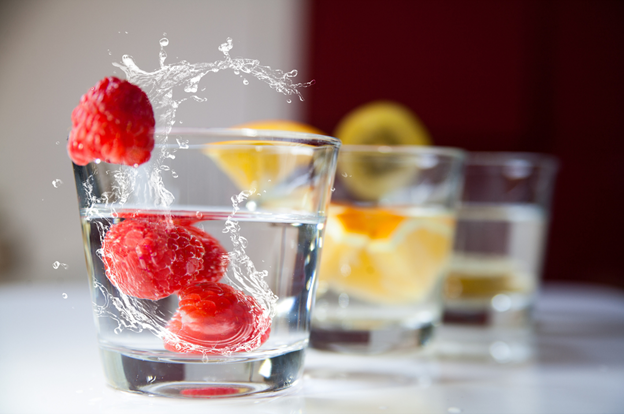By Maria Leon MHSc, RD, LDN
The summer months can be some of the best times of the year. The increasingly warm temperatures allow us to spend more time outside, enjoy each other’s company, and participate in various outdoor activities. As we spend more and more time in the summer heat, it is important to stay hydrated and replenish any losses from increased sweat production, physical activity, and any potential vomiting or diarrhea that may occur.
Water makes up about 60% of our body and is essential to help our body function including but not limited to lubricating our joints, protecting sensitive tissues, regulating body temperature, and helping to eliminate waste.
Consuming water from foods and beverages daily will help to refresh our water losses and prevent dehydration. Dehydration can lead to mood changes, constipation, headaches, fatigue, and kidney stones. One of the easiest ways to determine if you may be dehydrated is to look at the color of your urine. If your urine is dark yellow, it typically indicates dehydration. If your urine is a pale-yellow color, it usually indicates that you are well hydrated.
Hydration Tips:
- Use a reusable water bottle daily and aim to refill it throughout the day. You can even make it fun by choosing a water bottle in your favorite color, getting a matching bottle with your co-worker, or getting a design from a favorite movie, store, or related to a hobby or job.
- Add some flavor! There are a variety of different ways to add some flavor to water to make it more fun and enjoyable to consume. You can add fresh lemons, limes, oranges, and other citrus fruits to your water. You can also add different herbs such as mint or basil as well as different fruits and vegetables like cucumbers, berries, pineapple, etc. Some of my favorite combinations are strawberry and kiwi, cucumber and raspberry, and lemon and mint. You can even add just the juice of the lemon and lime as well, which can be found in any grocery store and do not have any added sugars.
- Increase consumption of water containing foods. Foods that contain 90-100% of water include cantaloupe, strawberries, watermelon, spinach, cabbage, lettuce, cooked squash, and celery. Foods that contain 70-89% of water include bananas, grapes, pears, oranges, pineapples, carrots, avocado, cooked broccoli, yogurt, cottage cheese, and ricotta cheese.
- Aim to consume water at mealtimes and in between meals. You can add ice cubes to ensure your water is cold and refreshing and/or use a reusable straw.
Fluid Needs:
Fluid needs vary from person to person based on age, gender, physical activity levels, environment, and health conditions. A general guideline for water intake is usually 11.5 cups daily for women and 15.5 cups daily for men. This includes water from both food and beverages.
However, it is best to speak with a health care professional and registered dietitian to help you determine your fluid needs. If you are interested in working with a registered dietitian this summer, St. Luke’s has a wide network of Registered Dietitians available at a variety of campuses. All you need is a referral from your physician and to give a call to our central scheduling department to make an appointment!
Resources:
- “4 Water." Institute of Medicine. 2005. Dietary Reference Intakes for Water, Potassium, Sodium, Chloride, and Sulfate. Washington, DC: The National Academies Press. https://doi.org/10.17226/10925.
- Water and healthier drinks. Centers for Disease Control and Prevention. June 6, 2022. https://www.cdc.gov/healthyweight/healthy_eating/water-and-healthier-drinks.html?CDC_AA_refVal=https%3A%2F%2Fwww.cdc.gov%2Fhealthywater%2Fdrinking%2Fnutrition%2Findex.html.
- Gordon B, Klemm S. How much water do you need? Academy of Nutrition and Dietetics: eatright.org. June 23, 2022. https://www.eatright.org/health/essential-nutrients/water/how-much-water-do-you-need.


 Quality Awards
Quality Awards
